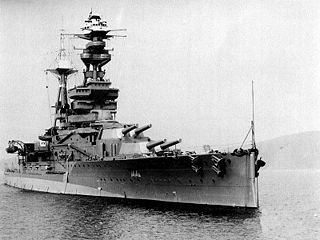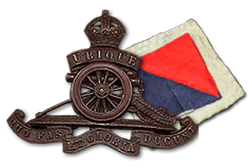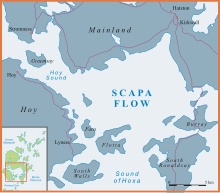
Hoy is an island in Orkney, Scotland, measuring 143 square kilometres (55 sq mi) – the second largest in the archipelago, after Mainland. A natural causeway, the Ayre, links the island to the smaller South Walls; the two islands are treated as one entity by the UK census. Hoy is also the name of a hamlet in the northwest of the island.

Scapa Flow is a body of water in the Orkney Islands, Scotland, sheltered by the islands of Mainland, Graemsay, Burray, South Ronaldsay and Hoy. Its sheltered waters have played an important role in travel, trade and conflict throughout the centuries. Vikings anchored their longships in Scapa Flow more than a thousand years ago. It was the United Kingdom's chief naval base during the First and Second World wars, but the facility was closed in 1956.

HMS Royal Oak was one of five Revenge-class battleships built for the Royal Navy during the First World War. Completed in 1916, the ship first saw combat at the Battle of Jutland as part of the Grand Fleet. In peacetime, she served in the Atlantic, Home and Mediterranean fleets, more than once coming under accidental attack. Royal Oak drew worldwide attention in 1928 when her senior officers were controversially court-martialled, an event that brought considerable embarrassment to what was then the world's largest navy. Attempts to modernise Royal Oak throughout her 25-year career could not fix her fundamental lack of speed and, by the start of the Second World War, she was no longer suitable for front-line duty.

HMS Iron Duke was a dreadnought battleship of the Royal Navy, the lead ship of her class, named in honour of Arthur Wellesley, 1st Duke of Wellington. She was built by Portsmouth Dockyard, and her keel laid in January 1912. Launched ten months later, she was commissioned into the Home Fleet in March 1914 as the fleet flagship. She was armed with a main battery of ten 13.5-inch (343 mm) guns and was capable of a top speed of 21.25 knots.

Graemsay is an island in the western approaches to Scapa Flow, in the Orkney Islands of Scotland. The island has two lighthouses. Graemsay lies within the parish of Stromness.

The Grand Fleet was the main battlefleet of the Royal Navy during the First World War. It was established in August 1914 and disbanded in April 1919. Its main base was Scapa Flow in the Orkney Islands.

Portland Harbour is located beside the Isle of Portland, Dorset, on the south coast of England. Construction of the harbour began in 1849; when completed in 1872, its 520-hectare (1,300-acre) surface area made it the largest human-made harbour in the world, and it remains one of the largest in the world today. It is naturally sheltered by Portland to the south, Chesil Beach to the west and mainland Dorset to the north. It consists of four breakwaters: two southern and two northern. These have a total length of 4.57 km (2.84 mi) and enclose approximately 1,000 ha of water.
Gutter Sound is a sound in Orkney, Scotland, part of Scapa Flow. It lies to the west of the main harbour between the internal islands of Cava and Fara, and the large outer island of Hoy. Gutter Sound was one of the sites of the scuttling of the interned Imperial German High Seas Fleet in 1919, and the scene of a major salvage operation in the 1920s. The remaining wrecks are frequently visited by recreational divers.

Fort Rodd Hill National Historic Site is a 19th-century coastal artillery fort on the Colwood side of Esquimalt Harbour,. The site is adjacent to Fisgard Lighthouse National Historic Site, the first lighthouse on the west coast of Canada. Both the fort and lighthouse are managed and presented to the public by Parks Canada.

Glimps Holm or Glims Holm is a small uninhabited islet in Orkney, Scotland.

Lyness is a village on the east coast of the island of Hoy, Orkney, Scotland. The village is within the parish of Walls and Flotta, and is situated at the junction of the B9047 and B9048.

Yesnaby is a historic township in Sandwick, on the west coast of Orkney Mainland, Scotland, south of Skara Brae. It is renowned for its spectacular Old Red Sandstone coastal cliff scenery which includes sea stacks, blowholes, geos and frequently boiling seas. A car park, coastal trail and interpretive panels serve visitors. The area is popular with climbers because of Yesnaby Castle, a two-legged sea stack just south of the Brough of Bigging. The stack is sometimes described as a smaller version of the Old Man of Hoy. Yesnaby is also one of the very few places where Primula scotica grows.

The 1st Orkney Artillery Volunteers (OAV) was a part-time unit of Britain's Royal Artillery formed in the Orkney Islands in 1860 as a response to a French invasion threat. The unit served as coast artillery until it was disbanded after World War I.

HMS Castle Harbour was a civilian harbour vessel of 730 tons that was taken-up from trade (TUFT) during the Second World War by the Royal Naval Dockyard in Bermuda for use by the Royal Naval Examination Service and later armed and commissioned as a warship, providing harbour defence from submarines.
The Admiral Commanding, Orkneys and Shetlands was an operational commander of the Royal Navy. He was charged with the administration of the Orkney and Shetland Islands and operating and defending the fleet base at Scapa Flow that was the main anchorage for both the Home Fleet and Grand Fleet at various times.

The 101st Heavy Anti-Aircraft Regiment, Royal Artillery was an air defence unit of Britain's Territorial Army raised in northern Scotland just before World War II. After defending the naval base of Scapa Flow against air attack in the early part of the war, the regiment went to India and later took part in the Burma Campaign in the anti-aircraft role and with heavy howitzers in support of ground forces, even on occasion fighting as infantry. It was reformed in the post-war TA and continued until the abolition of Anti-Aircraft Command in 1955.

The 99th Heavy Anti-Aircraft Regiment, Royal Artillery was an air defence unit of Britain's Territorial Army (TA) during World War II. It defended London during the early part of the war, and later served in the campaign in North West Europe.

The Orkney Heavy Regiment was a Territorial Army unit of Britain's Royal Artillery raised in the Orkney Islands just before World War II. During the war it was greatly expanded to defend the vital naval base of Scapa Flow. It was reformed postwar and later became an air defence battery.

The Orkney Fortress Royal Engineers was a small and short-lived unit of Britain's Territorial Army raised just before World War II to assist in the defence of the Royal Navy base at Scapa Flow in the Orkney Islands.

541st Heavy Regiment, previously 1st Coast Artillery Group, was a Royal Artillery unit of the British Army stationed in the Shetland Islands during World War II. During the war it defended Lerwick and Sullom Voe. It was disbanded at the end of the war.

















